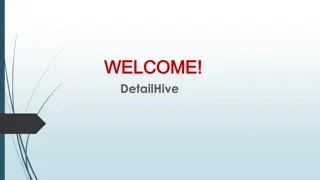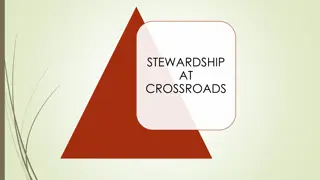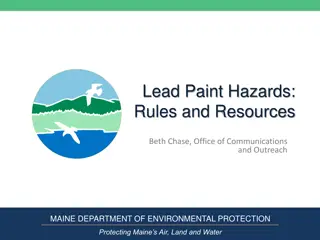Paint Stewardship in Canada: Information & Training Tutorial
This tutorial covers the paint collection programs in various Canadian provinces, such as British Columbia, Saskatchewan, and more. It discusses topics like product care, eco-fees, depot responsibilities, accepted products, recycling fees, and the role of Product Care Association of Canada in managing end-of-life products. Learn about the paint collection program and how it is administered to promote environmental stewardship.
Download Presentation

Please find below an Image/Link to download the presentation.
The content on the website is provided AS IS for your information and personal use only. It may not be sold, licensed, or shared on other websites without obtaining consent from the author.If you encounter any issues during the download, it is possible that the publisher has removed the file from their server.
You are allowed to download the files provided on this website for personal or commercial use, subject to the condition that they are used lawfully. All files are the property of their respective owners.
The content on the website is provided AS IS for your information and personal use only. It may not be sold, licensed, or shared on other websites without obtaining consent from the author.
E N D
Presentation Transcript
Paint Stewardship in Canada Information & Training Tutorial
Introduction This presentation concerns the paint collection programs in British Columbia, Saskatchewan, Manitoba, New Brunswick, Newfoundland & Labrador, PEI, and Nova Scotia. Topics covered: What is the paint collection program and Product care? What is an eco-fee? Depot responsibilities. Accepted and not accepted products in the program. How to handle accepted material. Who to contact for service.
What is Product Care? Product Care Association of Canada (PCA) is a non-profit organization. PCA manages end-of-life products from consumers (specifically manages the paint collection program). Product lifecycle: Consumer purchase consumer use collection service PCA recycles In some cases, this can be a circle, ideally the product is recycled back into the same product that the consumer can use again. The concept of managing products through their lifecycle is known as product stewardship.
What is the Paint Collection Program? It has been legislated by provincial governments for manufacturers or first importers to manage the end of life for their products. The paint collection program managed by PCA is the result of these regulations. Paint that consumers are finished using is collected and processed for recycling. The paint collection program is funded by eco-fees .
What is a Recycling Fee? (Also known as an EFH - Environmental Handling Fee) An EHF is a fee charged by PCA to its members to fund the product stewardship programs operated by PCA on their behalf under provincial recycling regulations. The fee is not a government tax and the fee itself is not remitted to government. Fee rates vary by product type and container size.
What is a Recycling Fee? (Also known as an EFH - Environmental Handling Fee) Fees are used by PCA to cover recycling program costs for the product, including public education, managing the collection, transportation and recycling system for returned products . Depending on the business practices and regulations of the provinces where the program operates, manufacturers, retailers and wholesalers may include the recycling fee in the product price or display it as a separate charge to purchasers or both. In either case, the EHF is part of the product price and is subject to sales tax.
What Service do Collection Sites Provide? Depots are a key component to the collection system. They provide a location for consumers to drop off their end-of-life products. In many cases, the public views them as the program.
The Collection System Receive program products from the consumer. This is NOT a self-drop system. Consumer drop-offs MUST be supervised. Be certain to carefully inspect each container. Follow PCA collection guidelines. Pack program products into collection containers.
The Collection System Collection containers should be stored in an area accessible only to collection site employees. This area can be either indoors or outside, wherever the best fit is. If the storage area is outside, it is recommended to weight or strap the lid. down, so that it cannot be blown off by high winds, and the paint is protected from weather. Contact PCA for service when your collection containers are full.
The Collection System Collection Containers: 45 GALLON DRUM TUBSKID
Site Safety Requirements Collection containers must not be accessible to the public. No leaking or compromised containers can be accepted. Abandoned containers should approached with caution and handled as hazardous waste. NEVER open a container to check its contents. Read the label on each container.
Site Safety Requirements Always wear safety glasses and gloves when handling dropped off material. No smoking near the paint collection area. Practise basic hygiene after handling paint (wash hands). NOTE: All drop-offs MUST be supervised. Unattended drop-off encourages abandonment and the collection of non-program materials.
Program Products Architectural Coatings (household type of paints) Consumer latex, alkyd, enamel and oil-based paints Porch, floor and deck paints Interior & exterior varnishes and urethanes Primers, undercoats, block fillers and sealers Marine enamels Wood finishing oils, stains and shellac
Program Products Latex driveway sealer Rust paint, decorative metal paint Fence, barn and swimming pool paint ANY paint aerosols Empty cans of the above products (except NS) Maximum size: 25 litres
Aerosols Aerosol PAINTS are included in the program and collected in either drums or tubskids. Any aerosol that is NOT a paint, is NOT to be accepted in the program. Place aerosol cans into the collection container, and close the lid. For drums, the ring does not have to be tightened each time.
Non-Program Products PCA cannot recycle all products. Many products are not part of the stewardship program and must not be accepted by collection sites. Any non-program products brought by the consumer must be returned to them and not accepted. Consumers with non-program product are requested to contact a municipal eco-centre or waste disposal centre in their area for disposal of the product. Non-program products include, but are not limited to: Products not listed as Program (accepted) products. Products without their original label. Products not in their original container. Products in leaking or unsealed containers.
Industrial Paint Some non-program material is obvious (caulking tubes, roof tar, resin, no label, etc.). Some non-program material is more difficult to identify, such as industrial paint. Some indicators that a paint is industrial: - Says for industrial use only on the can. - WHMIS labels are on the can. - TDG labels are on the can. - Has a part A and part B (two components). - Road marking paint. - Quick drying or rapid cure paints.
Non-Program Industrial Paint Indicators on the label such as quick drying are usually a sign that it is an industrial product Other symbols, such as this dangerous goods transportation label, indicate that a container is an industrial product and not acceptable in the program WHMIS labelling is another indicator that a product is for industrial or commercial-use and not accepted by the program
Non-Program Industrial Paint Part A, part B, or two-part paints are industrial and are therefore unacceptable Traffic marking paint is an industrial product and is not acceptable
Non-Program Industrial Paint This is an industrial catalyst and is not acceptable in the program Quick dry, rapid dry, rapid cure, fast dry, etc. are unacceptable as they are industrial paint products NO catalysts are accepted by the program
Non-Program Industrial Paint Colorants, tints and other paint additives are not accepted by the program Paint strippers are not acceptable
Other Non-Program Products Adhesives, roof tars, fibreglass resin Car paint (non aerosol)
Other Non-Program Products Leaking or unlabelled containers Industrial Paint
Other Non-Program Products Materials not in their original containers Cement, dry wall mud, grout
Other Non-Program Products Craft Paint Caulking Tubes
Collection Containers Paint: Tubskid (4 x4 x3 ) plastic box For paint products 200 litre (45 gallon) drums Pack paint aerosols into drums Not all collection sites
Packing Paint Products The Products are to be loosely packed, upright into collection containers. Do NOT empty out the containers! Place heavier 20 litre (5 gallon) pails in the bottom of the tubskid. Provides stability. Always close the lid following packing to keep rain out. ACCEPTABLE UNACCEPTABLE
Paint: Full Collection Containers Once half of any type of collection containers are full, you must contact PCA or the appropriate contractor for service (see following slide). Your pick-up will be scheduled. On the day of the scheduled pick-up, the driver will arrive. Ensure the collection containers are accessible and ready to ship. The driver will provide paperwork and labels for the containers. Review the paperwork for accuracy and sign off. Assist with loading the collection containers into the truck. Empty collection containers to replace the full ones picked up will either be dropped off simultaneously, or arrive prior to the pick-up of the full ones.
Service Contacts BC (Southern Interior) - Battery Doctors @ 250-860-2866 BC (All Other Regions) - PCA @ 1-877-592-2972 ext. 205 SK - PCA @ 1-877-592-2972 ext. 202 MB - PCA @ 1-877-592-2972 ext. 213 NL - Hebert s Recycling 709-747-4789 (Avalon, Burin, & Bonavista Peninsula) - Hebert s Recycling 709-634-3464 (West of Gloverton) - Hodge Brothers Transport 709-282-5000 (Labrador) NB - Hebert s Recycling 506-773-1880
Contact At PCA For any other questions regarding the Program, please contact us at: Lori@productcare.org























